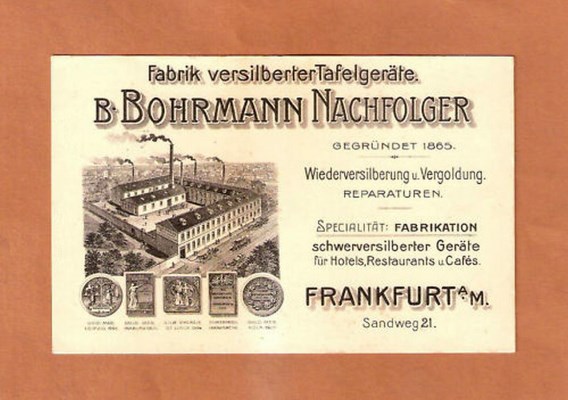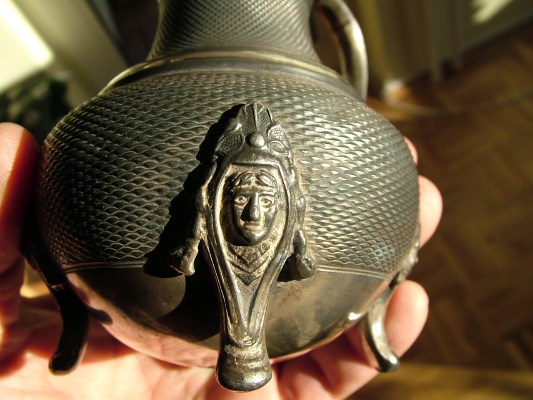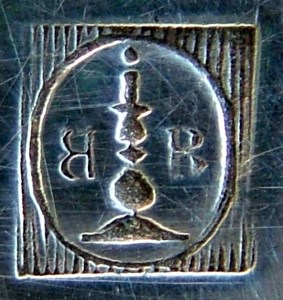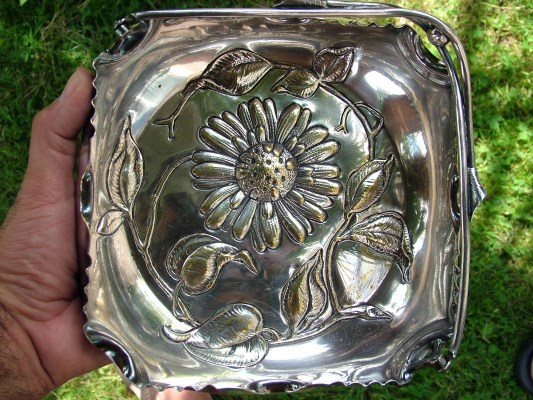A SMALL COLLECTION OF ANTIQUE SILVER |
| an article of Prof. David N. Nikogosyan for ASCAS - Association of Small Collectors of Antique Silver |

|
(click on photos to enlarge image)B.BOHRMANN / B.BOHRMANN NACHFOLGER (SUCCESSOR) COMPANY,
|

|
Teapot with the inscription Hôtel Metropole, produced by B.Bohrmann's successor August Grünebaum before 1881. |
From the information given in (Literature 2, 3), we can immediately deduce that Mr. B.Bohrmann died (or transferred the business to his successor) sometimes between 1877 and 1881. We will designate this year as YBD (year of B.Bohrmann death). In 1886 the number of workers at B.Bohrmann company reached 50 people (Literature 3) and therefore in 1889 the factory moved into more spacious premises located at Sandweg 21. From the beginning there were other firms sharing the entire building, but with time they all left and in 1908 B.Bohrmann Nachfolger Fabrik versilberter Tafelgeräte (the official name of the factory since at least 1887, which in English means "B.Bohrmann Successor Foundry of Silver-Plated Table Ware") became the sole tenant (Literature 3). This fact justifies the commercial success that B.Bohrmann Nachfolger company reached between 1889 and 1908.

|

|


|

|


|


|
Two similar spoons issued in 1876 with different marks:
|
Additional data on Bohrmann's factory history I found by studying the pieces from my collection. I purchased two similar spoons, issued in 1876, but bearing two different marks, one with two owners "BOHRMANN & STERN", the second with one owner "B.BOHRMANN", see the corresponding photos. From these photos it follows that in 1876 the company again became a sole owner enterprise. I want to emphasize that amongst the numerous marks, used by Bohrmann's factory in 19th century, a single-word inscription "B.BOHRMANN" always refers to Bohrmann himself, while the inscription "BOHRMANN" (without the initial "B") means Bohrmann's successor (in German Nachfolger).
Recently, I have found that between 1887 and 1899 the firm B.Bohrmann Nachfolger kept a strong cooperation with the metal ware factory Langglük in Esslingen. These two firms produced similar models with similar marks, but with different family names, BOHRMANN and LANGGLÜK. During this period, the B.Bohrmann successor company used also the marks with the family name GRÜNEBAUM.

|
A gravy boat teapot with the inscription BASTEI SACHS. SCHWEIZ,
|
All known data on the early history of Bohrmann's factory are collected in Table 1 below.
Achievements of B.Bohrmann's enterprise.
Quite early, at the end of 1860s, while producing silver-plated cutlery, B.Bohrmann started to use Neusilber as a base metal (indeed, alloy) for silvering. To the best of my knowledge, at that time nobody in Germany employed such a pioneering technology. Such technique was invented by Christofle company in France starting from c.1855 (Literature 6). For a base metal Christofle applied the name ALFENIDE, proposed by Charles Halphen (Literature 7). Similar base metal, but under the original name NICKELIDE, was introduced by the French jeweller Theodore Henry at the end of 1860's.
Similarly to Theodore Henry, Bohrmann applied the mark with the inscription NICKELIDE, but used instead of a rectangular box a prolonged oval. Sometimes the shortened inscription NICKEL was used. Such alloy's name on Bohrmann's cutlery was used until at least 1884.
In 1876 (if not earlier) B.Bohrmann introduced a very thick silver coating on his cutlery pieces, up to 120 grams per two dozen (24) standard spoons or forks about 22 cm long. This was the highest silver standard in the world at that time. The above-mentioned Christofle firm until 1899 used for silvering of 24 standard spoons or forks the amount of only 84 grams of silver. In Germany, the famous cutlery-producing firm August Wellner & Sons realised the standard of 100 grams only after the World War I.
Finally, I want to mention the wide use of punching technology in the Bohrmann's production of hollow ware pieces in the mid 1870s. Twenty years later such pieces became very fashionable and were produced in large quantities, e.g. by the Christofle branch Manufacture de L'Alfenide (Literature 8).
Main marks used by B.Bohrmann/ B.Bohrmann Nachfolger Company.
First I would like to present the famous graphic mark of B.Bohrmann's foundry, used both on cutlery and hollow ware from the 1860's until c.1887. By the way, it is the only Bohrmann's mark, mentioned by Reinhard Sänger in his book on German cutlery without any explanation/specification (Literature 9). This mark consists of a candle, set in an oval inside a hatched square and two "B" letters around the candle, taken from the initials of B.Bohrmann. The fascinating peculiarity of this mark is the fact that the left "B" letter is a mirror reflection of the right one and vice versa. In my opinion, this mirror reflection accounts for the wide use of punching at early stages of Bohrmann's hollow ware silver plate production. The size of the square box with "BB" mark is about 2.5 mm x 2.5 mm for the standard table cutlery and varies between 4.0 mm x 4.1 mm and 4.3 mm x 4.5 mm for hollow ware pieces. The early variety of this mark uses a rhombus instead of an oval and contains the image of a fork between BB initials.
Next I will discuss the first mark of B.Bohrmann Nachfolger company for silver-plated hollow ware items, used between 1887 and 1899. It also was used on silverplated cutlery items in the same time period. This mark consisted of the one-word inscription BOHRMANN given in the rectangular box (with rounded corners or without). Two digits in the rhombus, which is always put from the right of the word BOHRMANN, refer to the production year. The silver content mark (marks) was (were) put from the left side of the word BOHRMANN (usually), or above the BOHRMANN inscription (rarely on early pieces), or (in the case of cutlery) between the BOHRMANN inscription and the rhombus with the year digits. Below we will compare this Bohrmann mark with a similar mark used by its partner Langglük foundry in Esslingen between 1881 and 1899.
The comparison of these marks allows us to formulate the following conclusions:
1) This type of marking was invented by Langglük in 1881 or even earlier. Bohrmann used a similar mark only since 1887. That means, Bohrmann borrowed this mark from Langglük and not the opposite.
2) Early marks of Bohrmann issued in 1887-1893 (including a rare GRÜNEBAUM marking) used for the firm name the rectangular boxes with rounded corners, while the Langglük firm always used rectangular boxes without rounded corners.
3) Since 1896 Bohrmann company also used for the firm name the rectangular boxes without rounded corners.
These observations imply either a merger of Bohrmann and Langglük firms into one company (B.Bohrmann Nachfolger) during 1887-1899 period or at least a strong cooperation between them. Additional proof of the merger/strong cooperation could be the absolute identity between two hollow ware items in my collection, produced by Bohrmann (in 1896) and Langglük (in 1897). Another argument is the disappearance of the Langglük firm in the early beginning of XIX century, while the Bohrmann company continued its development.
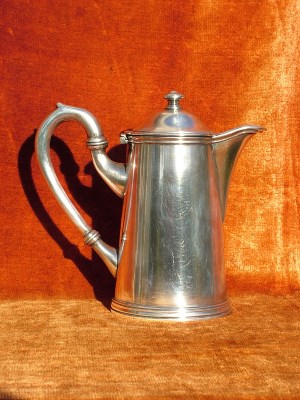

|
Two similar silver-plated coffee pots: (left) produced by Bohrmann in 1896, height 18.8 cm;
|
Now we will discuss the "round" mark, which was used on silver-plated hollow ware utensils from 1899 until c.1930. It combines the round inscription B.BOHRMANN NACHFOLGER with the horizontal one FRANKFURT A/M. The length of the word FRANKFURT varies between 8.9 and 9.9 mm. The digit from the left of the horizontal inscription FRANKFURT A/M shows the amount of silver used for silvering (in grams), while the digit from the right of the mentioned inscription, set in rhombus, shows the last two digits of the production year. In 1913, the four-digit year presentation was used also on the round mark. The reason for the four-digit presentation is still unknown.
The last Bohrmann's company mark for silver-plated hollow ware pieces, used before the World War II, kept the same text content as the round mark, but was made in two lines inside a fancy shield of prolonged form. The length of the inscription BOHRMANN varies between 10.6 and 11.0 mm. The length of the word FRANKFURT varies between 11.9 and 12.1 mm. Again there are two digits from the left and from the right of the shield. The left digit refers to the amount of silver, used for silvering (in grams). The right digit, put in rhombus, shows the last two digits of the production year. This mark was used between 1930 and 1940. From 1935, the four-digit year presentation was used.
During World War II and after, the production at B.Bohrmann Nachfolger (Successor) company in Frankfurt on Main started to decline. This is not surprising taking in account the total decay/crisis of world silver-plating industry. Nevertheless, the firm was acting at least until the 1954. Surprisingly, it even opened a branch in Hilversum, Holland (see the photos attached).


|
The round B.Bohrmann mark used in 1954 and 1965 on silver-plated items, produced in Frankfurt on Main and in Hilversum, respectively. |
Literature
1. D.N. Nikogosyan: Marks of European Silver Plate: III. Bohrmann, Hartmann & Hepp, Germany; (2009)
2. Archivportal Thüringen. Note Nr.3338, 24th September, 1877. "B.Bohhrmann. Fabrikant in Frankfurt am Main, Fabrik versilberter Tafelgeräte, alleiniger Inhaber der Firma Bohrmann", in German. (English translation of the note: "B.Bohrmann. Businessman from Frankfurt on Main, Factory of Silver-Plated Utensils, Sole Owner of Bohrmann Company").
http://www.archive-in-thueringen.de/de/suche/erweitert
3. Volker Rödel: Fabrikarchitektur in Frankfurt am Main 1774-1924, 1984, in German. (English translation of the title "The Architecture of Factories in Frankfurt on Main between 1774 and 1924").
http://www.frankfurt-nordend.de/fabrikarchitektur.htm#Katalog
4. The History of the Family of Anne Frank from Frankfurt on Main.
https://artsandculture.google.com/exhibit/
CAICnOLtC0lDLg
5. Anne Frank: The Diary of a Young Girl. 1942-1944.
https://archive.org/stream/AnneFrank
TheDiaryOfAYoung
Girl_201606/Anne-Frank-The-Diary-Of-A-Young-Girl_djvu.txt
6. D.N. Nikogosyan: Marks of French Silver-Plated Cutlery in the XIXth Century. Christofle, Veuve Charles Halphen, Gombault-Desclercs & Manufacture de L'Alfenide; (2014)
7. D.N. Nikogosyan: Gallia and its Predecessors: History and Marks. Silver Magazine, Vol.55, No.5, pp.32-40 2013
8. Manufacture de L'Alfénide, F. Cheron & Co, Supplément, Métal Anglais Argente et non Argente, Paris, in French, issued in 1891, 1896, 1897, 1898, 1899, 1900.
9. Reinhard W. Sänger. Das deutsche Silber-Besteck Biedermeier, Historismus, Jugendstil (1805-1914). Firmen, Techniken, Designer und
Dekore. (Stuttgart: Arnoldsche Art Publishers, 1991), pp.1-286, in German. (English translation of the title "German Silver Cutlery. Biedermeier Period, Historicism, Art Nouveau (1805-1918). Firms, Techniques, Designers and Decors").
go to B.BOHRMANN / B.BOHRMANN NACHFOLGER (SUCCESSOR) COMPANY FRANKFURT/MAIN, GERMANY. 2. LIST OF MARKS.
Dr. David N. Nikogosyan, Bonn, Germany
- 2019 -
 www.silvercollection.it |
|
This is a page of A Small Collection of
Antique Silver and Objects of vertu, a 1500 pages richly illustrated website offering all you need to know about
antique silver, sterling silver, silverplate, Sheffield plate, electroplate silver,
silverware, flatware, tea services and tea complements, marks and hallmarks, articles,
books, auction catalogs, famous silversmiths (Tiffany, Gorham, Jensen, Elkington),
history, oddities ... HOME - SITE MAP - SILVER DICTIONARY - COOKIES CONSENT AND PRIVACY OTHER ARTICLES ABOUT: ANTIQUE SILVER SILVER PLATE ENGLISH SILVER FRENCH SILVER |
